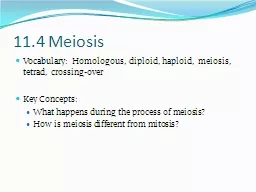

Key Concepts What happens during the process of meiosis How is meiosis different from mitosis Types of Reproduction Section 114 ASEXUAL SEXUAL 1 One Parent 2 Binary fission in prokaryotes or mitosis in eukaryotes ID: 708920
Download Presentation The PPT/PDF document "11.4 Meiosis Vocabulary: Homologous, dip..." is the property of its rightful owner. Permission is granted to download and print the materials on this web site for personal, non-commercial use only, and to display it on your personal computer provided you do not modify the materials and that you retain all copyright notices contained in the materials. By downloading content from our website, you accept the terms of this agreement.
Slide1
11.4 Meiosis
Vocabulary: Homologous, diploid, haploid, meiosis, tetrad, crossing-over
Key Concepts:
What happens during the process of meiosis?
How is meiosis different from mitosis?Slide2
Types of
Reproduction
Section 11-4
ASEXUAL
SEXUAL
1. One Parent
2. Binary fission (in prokaryotes) or mitosis in (eukaryotes).
3. Offspring are a clone of the parent. Not genetically different.
1. 2 parents.
2. Results in union of sex cells (egg & sperm or pollen in plants) Sex cells are called gametes.
3. Offspring not clones of parent. Genetically different.Slide3
METHODS OF ASEXUAL REPRODUCTION Slide4
SEXUAL REPRODUCTION
1. Chromosomes come in pairs called
HOMOLOGOUS PAIRS.
A.
Remember
– one of each pair is from each parent.
B. Humans have 23 homologous pair.
2. 1 – 22 pairs are called
autosomes. Normal body cells (muscle, nerve, bone, skin etc) have 23 pairs of chromosomes.
3. 23rd pair (either XX or XY) are called sex chromosomes
4. Normal body cells are Diploid (2N) and sex cells are Haploid (1N) (half of Diploid)Slide5
EXAMPLES IN ORGANISMS OF 1N & 2N
1. A cat has 38 chromosomes (2N) in its normal body cells. Its sex cells (sperm or egg) has half this # (1N) (19). A chicken has 39 chromosomes in its sex cells (1N) thus it has 78 in its normal body cells.
2. Thus when in humans sperm (23 chromosomes) meets the egg (23 chromosomes) the chromosome number of the fertilized egg (called a zygote) is 46. Thus 1N & 1N = 2N.The fertilized egg then divides by mitosis (asexual reproduction) to keep all somatic (body) cells at 46.
3. Thus, their most be another type of cell division that cuts the chromosome number in half . This division is called
MEIOSIS.Slide6
Example of how gametes join together to make a fertilized egg (zygote.)Slide7
Section 11-4
Figure 11-15 Meiosis
Meiosis ISlide8
Meiosis II
Meiosis I results in two haploid (N) daughter cells, each with half the number of chromosomes as the original.
Prophase II
Metaphase II
Anaphase II
Telophase II
The chromosomes line up in a similar way to the metaphase stage of mitosis.
The sister chromatids separate and move toward opposite ends of the cell.
Meiosis II results in four haploid (N) daughter cells.
Section 11-4Slide9
Note how crossing over happens and how the final 4 cells only have one of each homologous pair.
Parent or mother cell
4 Daughter cellsSlide10
Note that sperm production usually produces 4 viable (usable) sperm while females only produce 1 usable egg.Slide11
MOST IMPORTANT PURPOSES OF MEIOSIS
1. Each sex cell (gamete) receives
1 CHROMOSOME FROM EACH
HOMOLOGOUS (MATCHING) PAIR NEVER BOTH!!
2. Meiosis creates genetic variation in organisms by:
A. Chromosomes assort themselves in gametes independently.
B. Different chromosome combinations possible in a sex cell
C. Crossing over can produce even more genetic variation.Slide12
Section 11-4
Crossing-Over
HOW CROSSING OVER CAN HAPPEN – DURING PROPHASE
I
REMEMBER – This does not have to happen but it can!